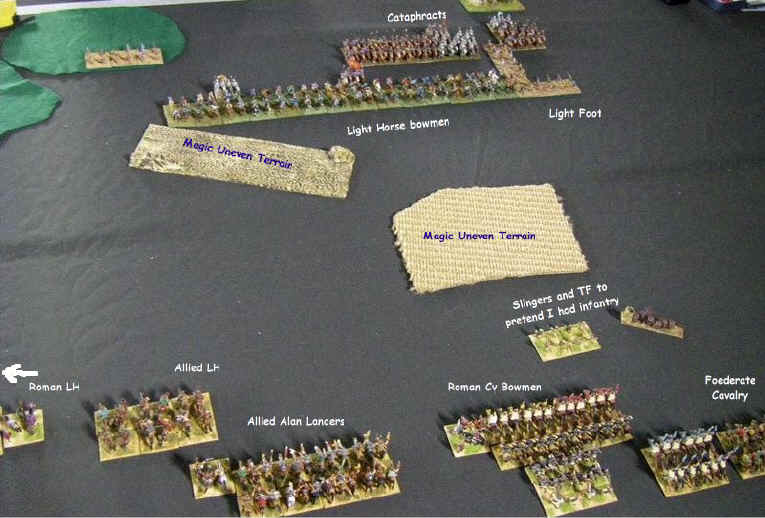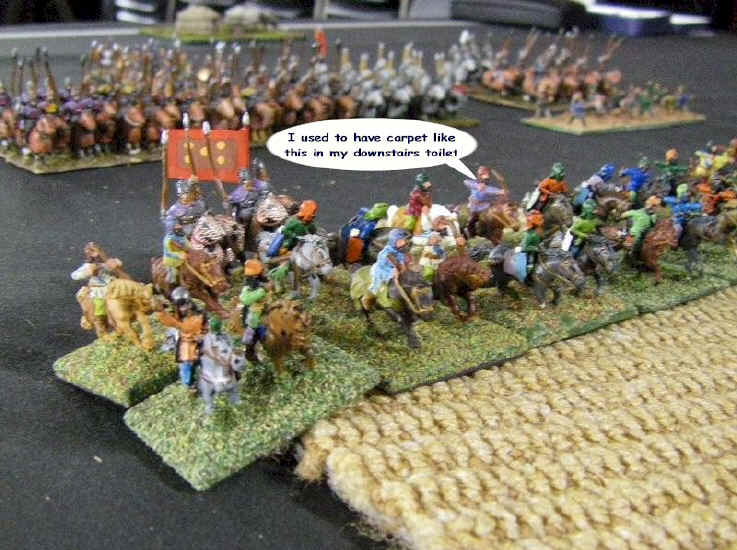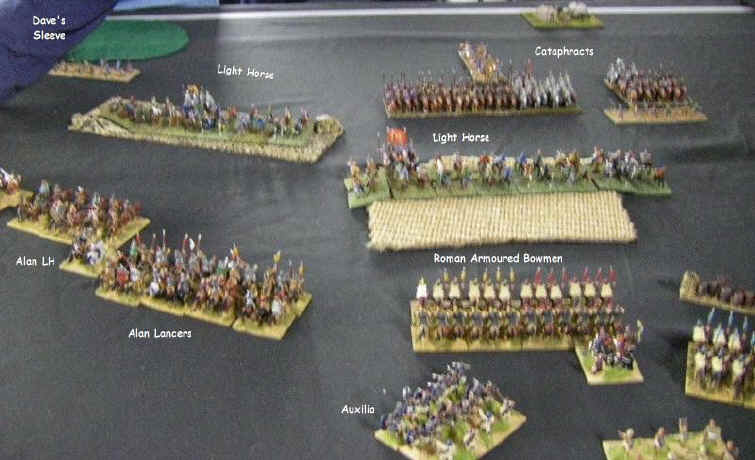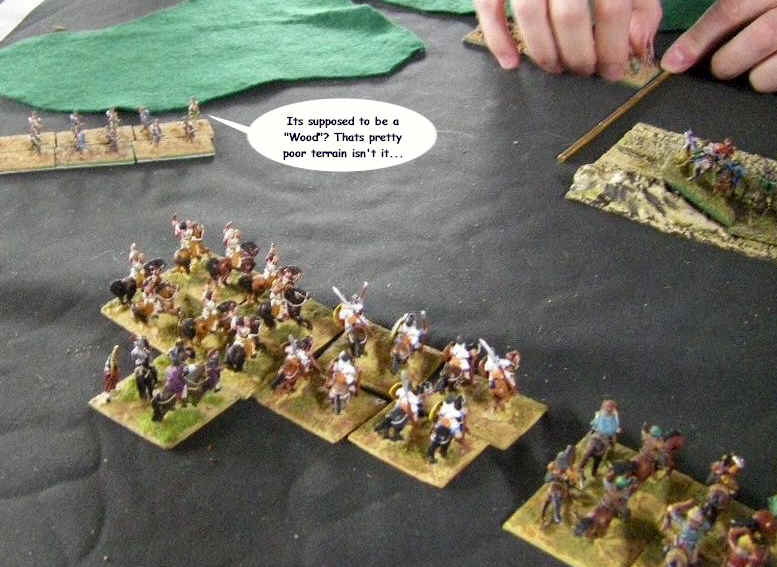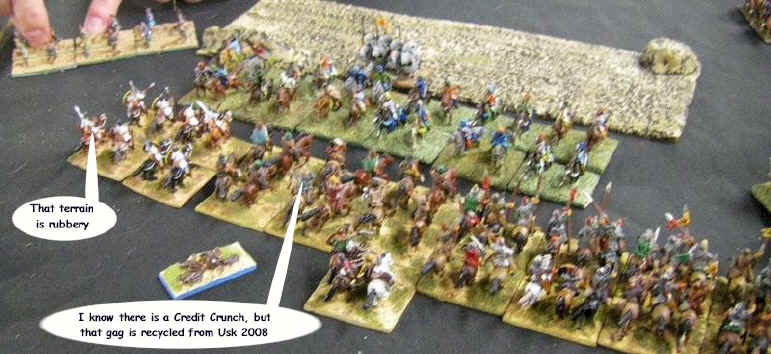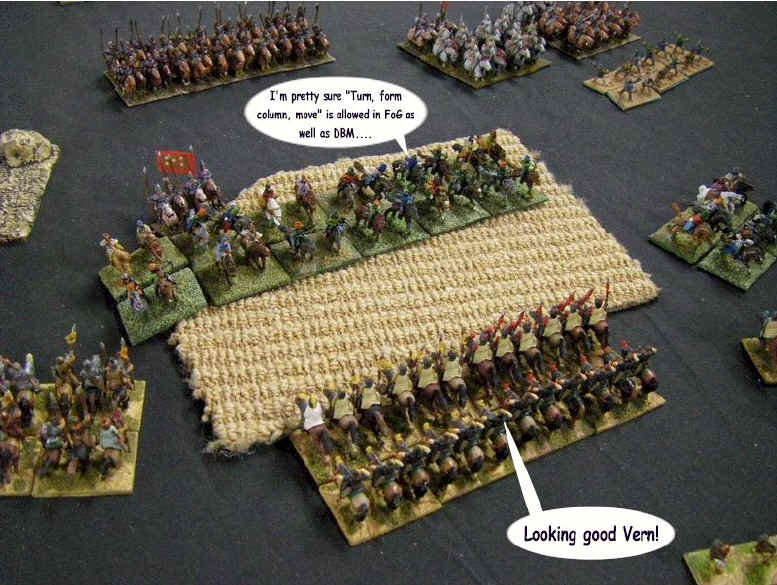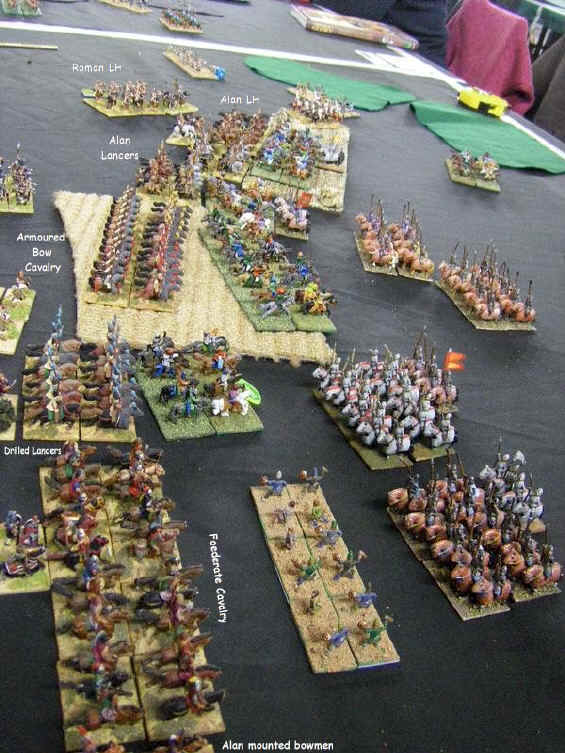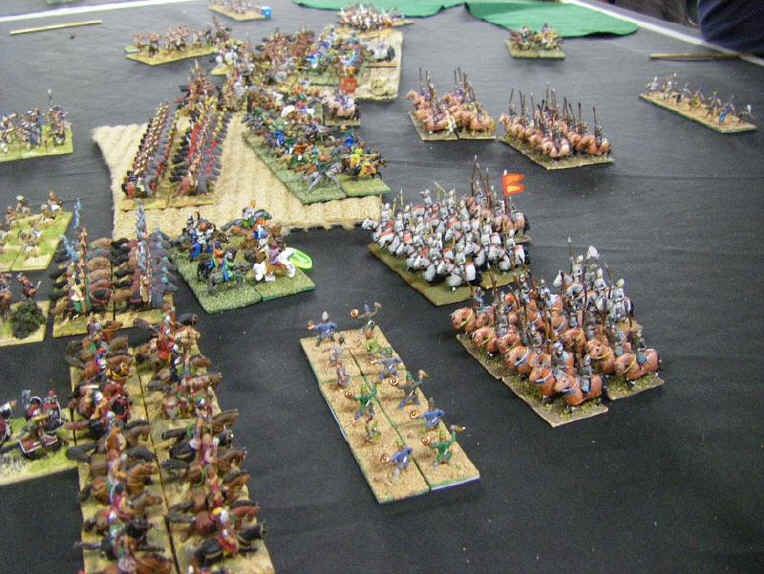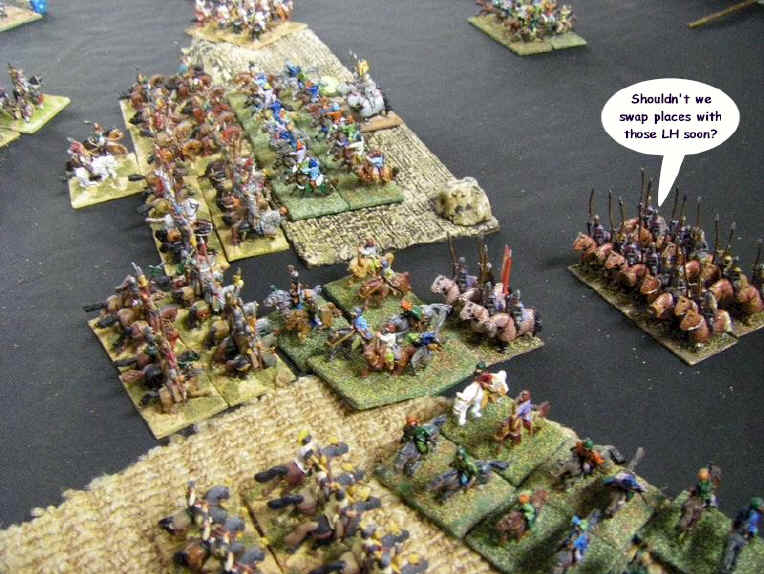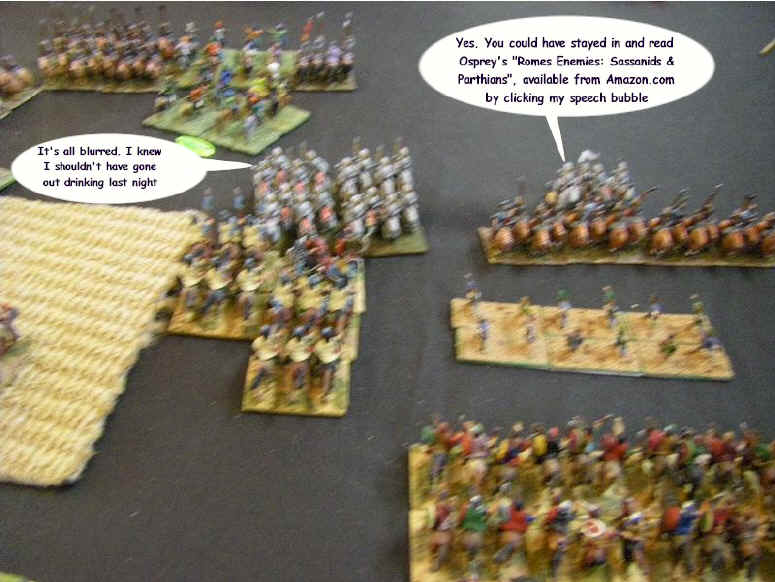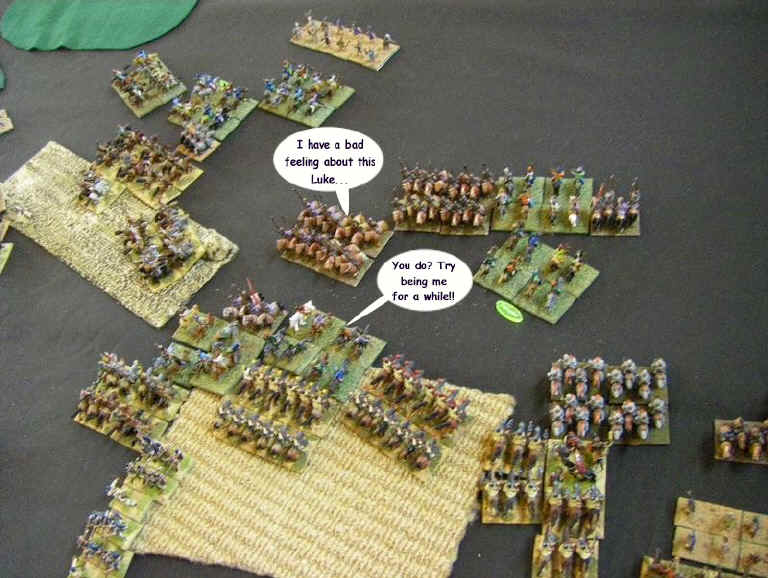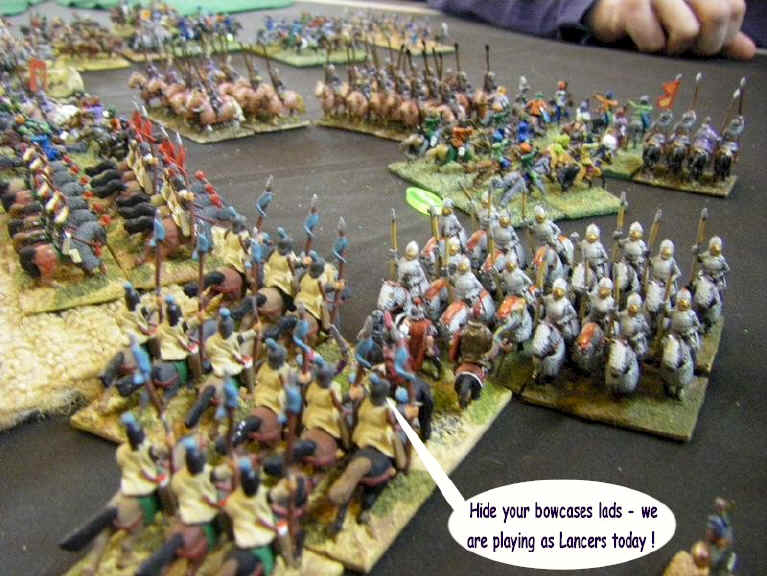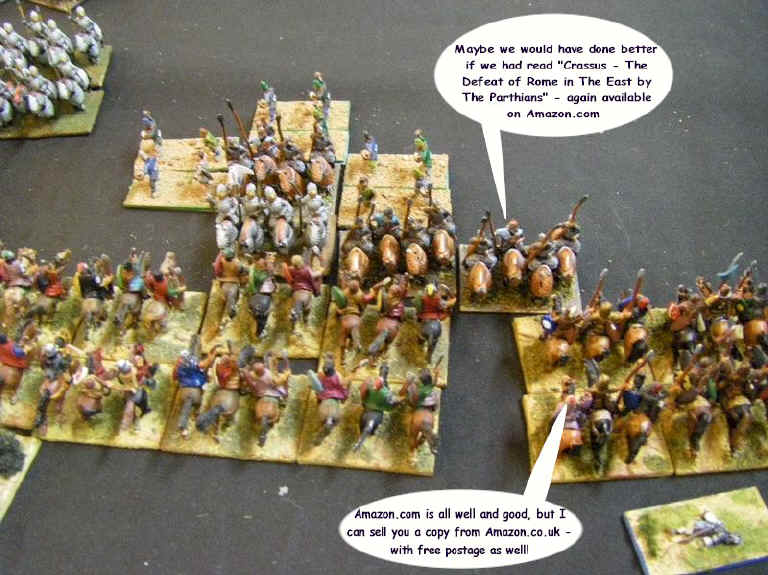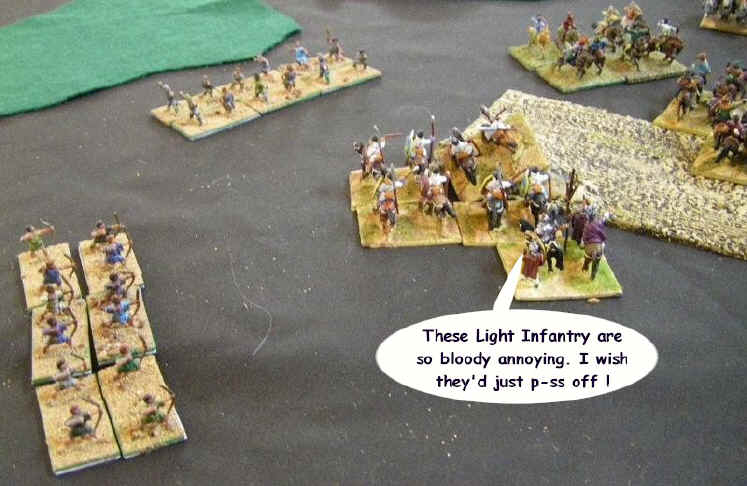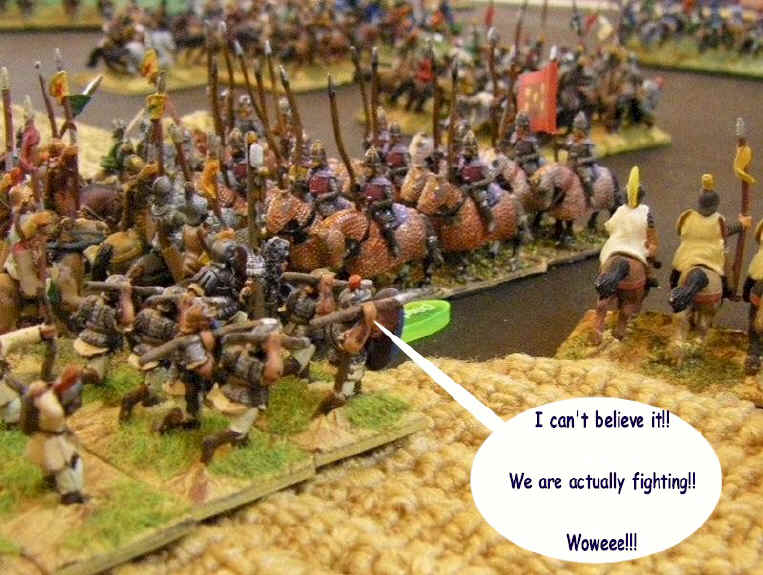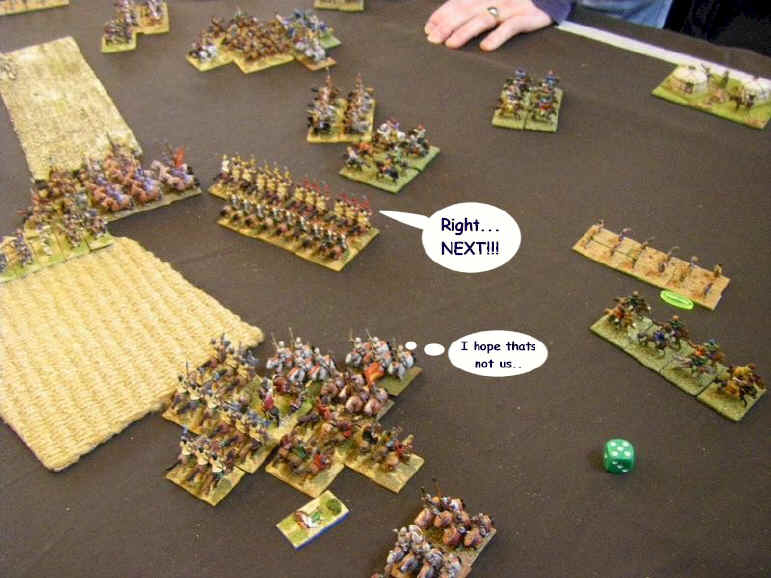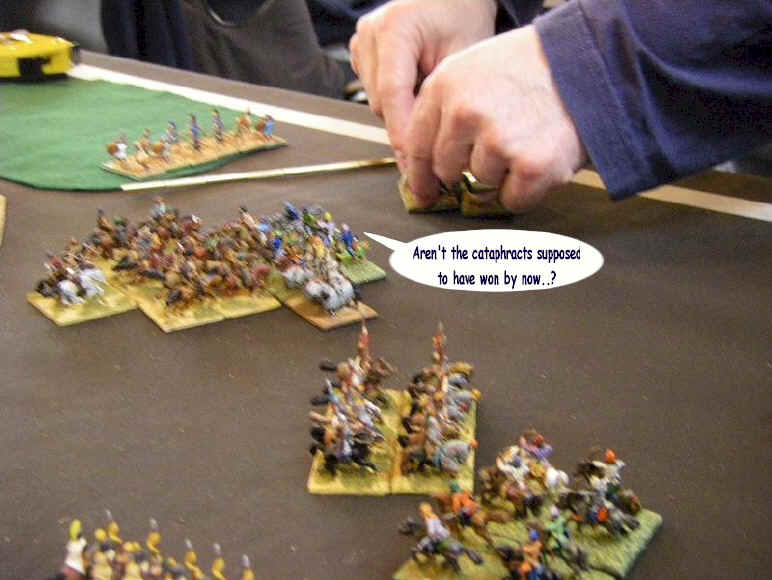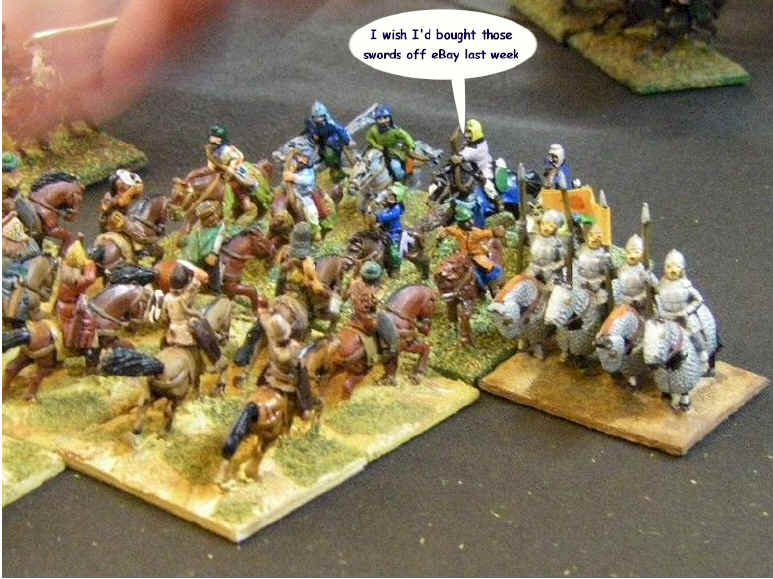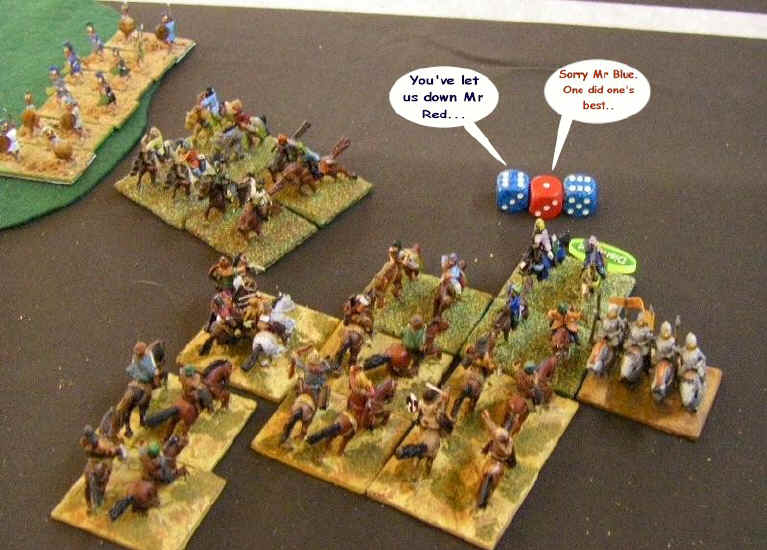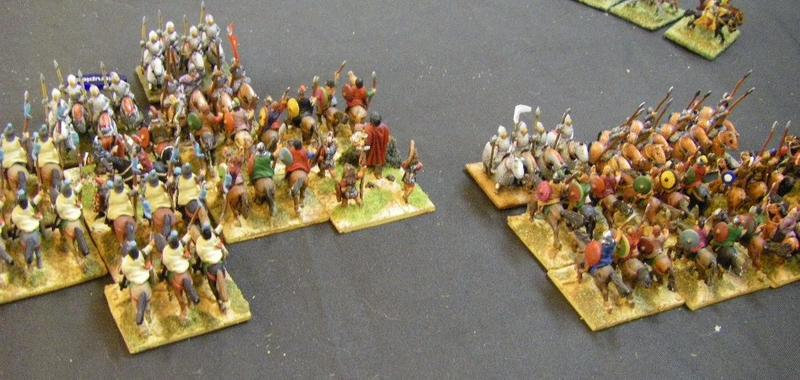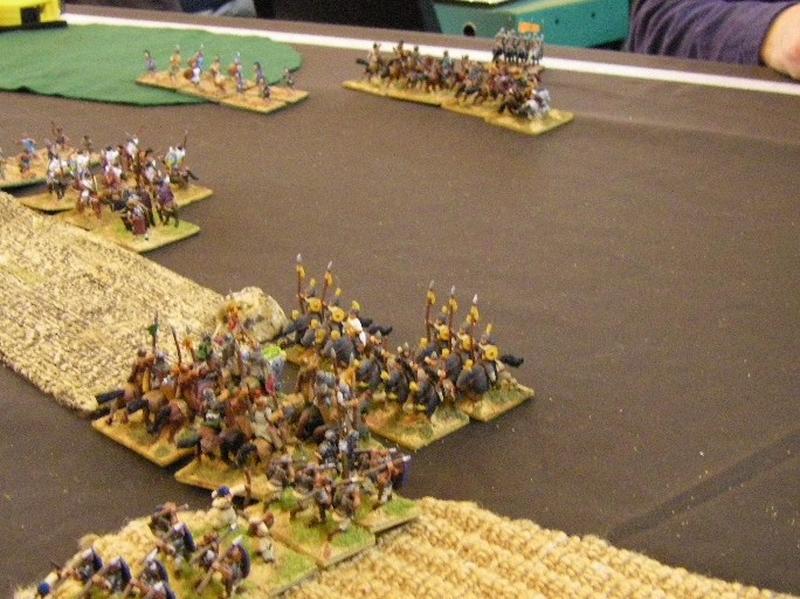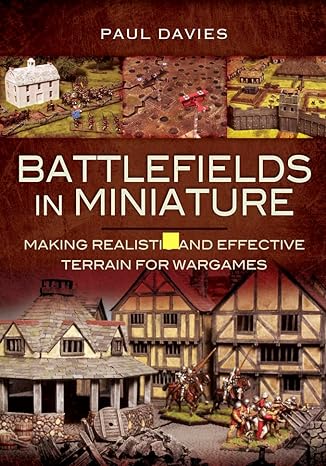Field of Glory Wargaming at Roll Call 2008
As the Good Doctor had managed to grind out our game far beyond what was humane, time was too short to sneak into Wycombe and sample the culinary delights, but surprisingly there was food on site.
Holding Roll Call in a school had allowed the organisers to dragoon in some proper School Dinner food. For those of you from outside the UK, here is a clip of Celebrity Chef Gordon Ramsay in his formative years experiencing British School Dinners.
After a satisfying curry & rice, I faced the afternoons game with some hope. I had made some mistakes in the first game, but I thought I knew what they were. My Foederate Roman Army had not proved a total washout, and with a bit more thought it seemed to have potential. And I'd worked out that the protected lancers Foederate cavalry were actually "good value" rather than "a bleeding liability" when fighting heavily armoured troops.
The afternoon game saw me facing Dave Fairhurst and his Parthian army. So, like Sassanids then. But with more of the stuff I couldn't beat, and less of the stuff I could. Great!
You can see the list and find out all about the Parthians here
Pictures of Parthian Troops from my Ancients Photo Directory
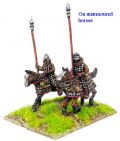 |
 |
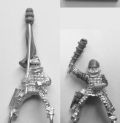 |
 |
This time - knowing I might be facing a load of heavy lancers and not much else - I deployed a couple of the super-clever "uneven" terrain pieces. These meant lancer armed cavalry would not count their lance "+" in combat - as charging in with a "+" for lances was basically what they did, I felt my opponent might be very reluctant to move his cataphracts into such terrain. Fortunately some of the pieces landed smack in the middle of the board this time - but again the Parthians deployed tightly bunched up and slightly offset to one side of the table, with loads of cataphracts hiding behind a screen of light horse.
The Parthian skirmish screen screamed forward ahead of their cataphracts, led by their commander - General Deja-Vu.
But this time with no terrain for the enemy to hide behind and trick me at deployment with, my own troops were driving pace of the battle. In the middle my armoured bowmen were teed up to drive the Parthians out of the uneven going. Even the Poor auxilia (they were Poor classified - I didn't have any reason to feel sorry for them or anything, in fact they were brand new and freshly painted so they had a lot to be grateful for to be honest.)
On the left I had a powerful combination of, well, "more" LH than the Parthians, and also some armoured Alan lancers to absorb shooting casualties and protect my own bow cavalry.
With numbers on my side I pushed forward confidently, and inevitably came off worst in the shooting. At least this time the Alan general was to hand to bolster ALL his men!
My Roman cavalry moved up confidently, but as it turned out incompetently. They had failed to square up against the larger number of Parthian horse archers and found the effect of their shooting reduced as they split their fire against too many units - added of course to the effects of disorder due to the uneven ground.
Tactical Tip. Shooting dice are per target unit, and always "round down" as well. With my formation offset against the Parthian units, I effectively wasted the shooting of both end files of my line, as I had 2 single-dice against 4-strong units of Parthians - leaving me unable to score the 2 hits needed to make them take a test. I ended up with just the potential of causing a reaction test with my 2 dice in the middle (2 front rank, one rear, but losing 1 per 3 for disorder). If I had been "square" against 2 of the Parthian units I would have had 2 chances at "effective" shots.
At least the Cataphracts were still wondering how to commit themselves to battle!
Soon it started to look like a real game of soldiers!
With only 4 units of cataphracts in play, the Parthians had been tempted into splitting up their formation to go hunting Romans, and now were advancing in 4 un-connected blocks. This was exactly what I had been hoping to engineer, as it allowed me to put 2 of my units against each Cataphract block - and with nothing of consequence to fill the gaps, the Parthians would be advantaged in melee - but seriously outnumbered 2:1 in each case.
But in an extra bonus, some of the Parthian LH bowmen were finding themselves trapped in front of their battle line! In DBM they would have been able to turn tail, and form a column to exit through the gaps between the cataphracts, however in FOG the "turn AND contract" malarkey was out of the question.
In the foreground, both armies jockeyed for that crucial position in which their charge would be triggered by the enemy - I really wanted to force some of the Cataphracts to charge forwards, creating a staggered line and potentially exposing flanks in the process.
The Alans were getting up close and personal with the Parthian light horse - and the combination of heavier lancers and my own light horse made it hard for the Parthians to stick around, as they dare not be charged by both. Meanwhile the Cataphracts waited nervously to take to the main stage ..
On my right, the threat of some of my cavalry maneuvering round their flank meant the Parthians were forced into thinning their lines to a dangerous extent to try and widen their frontage. My first unit of (average) lancers decided of their own volition that this was the time to charge in and the whole room shook with the impact (hence the dodgy camera shake effect - honest). Shock cavalry may charge without orders. I had attached a general to the unit to try and prevent them doing so, but in this case it had failed.
The average lancers were hardly what I would have chosen to lead with, but if they held I would be able to push past them on the left and potentially attack their flank. In the middle the Parthian light horse were in all sorts of trouble as Alan and Roman armoured cavalry closed up on them, and the fragile skirmish screen to the left was swept away, opening up opportunities for more Alans to envelop the Parthian Cataphracts
It was desperately important for my average lancers to hold on, and with a general in the front rank they fought bravely as the Parthians struggled to control 4 units of cataphracts and also to marshal and recover their light horse.
But on the far right, things were much better, I had managed to hit the thinned-down cataphracts with 3 units simultaneously, and crucially had killed one of the cataphracts at impact. The Parthians decided to remove the base opposite some of my Superior Foederate cavalry as the other flank saw them fighting only average troops, and that flank was much more at risk of being turned if they lost that element.
Back to the left and Roman light horse were engaged in a game of cat and mouse with Parthian infantry, who were adopting scoot and shoot tactics to come in and out of the woodland to harass the Romans, necessitating the allocation of a general to that flank.
With the central cataphract unit blocking the potential retreat route of their own light horse the Parthians decided the only solution was to form a column - hoping this would get them out of charge reach of the Alans to their flank, and opening up an escape route for the light horse, But it looked messy.
And "messy" it proved to be! The Alans on the flank were still in
range - so they could charge the Cataphracts in the flank. All the units charged
in, with the Parthian light horse evading from one lot of Alans in column down
the side of their own cataphracts - and ending up in the way of the oncoming
other Alans making their flank charge! .In the middle both units of Roman
armoured horse archers clashed with the 4th Cataphract unit. Battle was joined!!
On the right, the Foederate cavalry, finding themselves suddenly unopposed as the element facing them died, decided to charge forward and help out the Average Roman lancers - and despite suffering casualties their arrival started to tip the balance as the Romans now were double-teaming every Cataphract unit on the board.
In the middle the Parthian light horse had been immediately swept away after being it in the flank by Alan lancers - but this had saved the Cataphracts from being flank charged themselves. However the uneven terrain made it difficult for Parthians to expand effectively, and allowed the unlikely Roman Poor Auxilia to move up into overlap and add their inconsiderable firepower to the fray.
The first cataphract unit to crumble was the one in the middle facing the 2 superior Roman units - by the rest were also being eroded under repeated combats against far greater forces. The Roman cavalry in the middle were left with almost too many choices as where to head next.
With Alan cavalry threatening to sweep them from the board, the Parthian horse archers were forced into making a stand - outnumbered 3:2 and without swords...
Even the presence of a general struggled to help them out
With the cataphracts still engaged looking doomed to defeat, the Romans carried on their breakthrough in the center and sought to mop up the remaining Parthian light horse.
The Parthians were taking a pounding - losing another round of combat, they bravely rolled a "12" for their cohesion test - but a "1" for their casualties, and autobroke with 50% losses!
On my right, it seemed the Parthian Cataphracts would need to lose all 4 elements before fleeing the table! But inevitably, one broke - it was the one that started fighting first, and was facing 2 generals! My average lancers had survived - intact - to win the day!
This carved an even greater hole in the Parthian army, and the now-freed-up Romans swung round to roll up the rest of the wing, as Alan lancers raced towards the baggage.
In the center, the Roman horse archers returned to the fray to polish off the remaining Cataphract unit - caught between 2 charging formations, it simply evaporated - and the battle was won!
Post Match Summary
This worked out a lot better - I had realised that my cavalry could beat cataphracts with a 2:1 advantage of numbers, and the Parthians had been unfortunate enough to be fielding exactly half as many cataphracts as I had cavalry.
The terrain had also fallen well for me, with the "super magic" uneven ground proving too tempting for the LH (their move distance is unaffected by it), but they had then gotten pinned between the two battle lines and also been unable to really do anything about my better coordinated cavalry and light horse advance.
I had also massed my forces far better than in the first game, hitting in coherent blocks, and putting all my light horse on one wing had also helped create a situation where I had the advantage.
Hannibal's Post Match Analysis
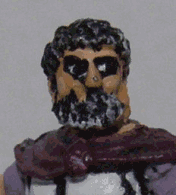
You know what. That performance actually was starting to show some signs of basic competence.
I'm still not totally happy with this "take on the enemies best troops" approach, but if you are obsessed with such suicidal ideas, doing so at 2:1 odd is half decent.
Of course, I would have looked to engineer at least 3:1 to make sure of winning more quickly, AND then managed to do some flank changes as well. But then again, you aren't me are you - and they do say, if the beard doesn't fit, Santa won't come down your chimney will he?
I do wonder however how you would have coped with an enemy with more cataphracts - if your army can only take on 4 units, you could be struggling against any more. And that Parthian bloke won't be leaving his LH to get squished between the lines any time soon, will he?
NEXT!!!
The stage was set for the next round
The Ancient Army List Index
The Rise of Rome (280 BC to 25 BC) Mid Republican Roman ; Late Republican Roman ; Gallic ; Pyrrhic ; Later Carthaginian ; Ancient Spanish ; Later Macedonian ; Later Seleucid ; Later Ptolemaic ; Attalid Pergamene ; Numidian or early Moorish ; Pontic ; Early Armenian ; Parthian ; Later Jewish ; Illyrian ; Spartacus Slave Revolt ; Bosporan ;
Storm of Arrows - Western Europe in the Later Middle Ages (1300 AD to 1500 AD) Medieval French ; 100-yrs War English (Continental) ; 100-yrs War English (Britain) ; Later Medieval Scots ( Britain) ; Later Medieval Scots (Continental) ; Later Scots Isles & Highlands ; Medieval Welsh ; Later Anglo-Irish ; Medieval Irish ; Low Countries ; Later Medieval German ; Italian Condotta ; Swiss ; Free Company ; Medieval Burgundian ; Medieval Danish ; Medieval Swedish ; Medieval Castilian ; Medieval Crown of Aragon ; Medieval Portugese ; Later Granadine ; Navarrese ; Ordonnance French ; Wars of the Roses English ; Ordonnance Burgundian ; Santa Hermandad Nueva Castilian
Immortal Fire - The Greek, Persian & Macedonian Wars (550 BC - 146 BC)
Classical Greek ;
Early Achaemenid Persian ;
Lydian ;
Thracian ;
Syracusan ;
Early Carthaginian ;
Skythian or Saka ;
Kyrenean Greek ;
Late Dynastic Egyptian ;
Alexandrian Macedonian ;
Later Achaemenid Persian ;
Classical Indian ;
Early Successor ;
Early Sarmatian ;
Galatian ;
Hellenistic Greek ;
Graeco-Bactrian ;
Graeco-Indian ;
Indo-Greek :
Legions Triumphant - Imperial Rome (25 BC to 493 AD) Dominate Roman ; Principate Roman ; Foederate Roman ; Later Sarmatian ; Early German ; Dacian or Carpi ; Ancient British ; Caledonian ; Early Alan ; Jewish Revolt ; Sassanid Persian ; Kushan or Indo-Skythian ; Palmyran ; Early Frankish, Alamanni, Burgundi, Limigantes, Rugian, Suevi or Turcilingi ; Western Hunnic ; Early Visigothic & Early Vandal ; Early Ostrogothic, Herul, Sciri or Taifali ; Early Anglo-Saxon, Bavarian, Frisian, Old Saxon or Thuringian ; Gepid or Early Lombard ; Early Scots Irish ; Early Pictish ; Hephthalite Hunnic ;
Swords & Scimitars - The Crusades (1096 AD to 1311 AD) Early Crusader ; Later Crusader ; Fatimid Egyptian ; Georgian ; Seljuk Turk ; Cuman ; Komnenan Byzantine ; Post Latin Conquest Byzantine ; Ilkhanid Mongol ; Mamluk Egyptian ; Cilician Armenian ; Syrian States ; Khwarazmian ; Ayyubid Egyptian ; Middle Serbian ; Middle Bulgarian ; Medieval Cypriot ; Latin Greece ; Pecheneg ;
Eternal Empire - Eastern Europe and the Rise of the Ottomans (1300 AD to 1500 AD) Early Ottoman Turkish ; Later Ottoman Turkish ; Tatar ; Later Russian ; Later Serbian Empire ; Later Bulgarian ; Later Lithuanian ; Later Polish ; Later Teutonic Knights ; Catalan Company ; Middle Hungarian ; Moldavian or Wallachian ; Albanian ; Timurid, White Sheep Turcoman or Black Sheep Turcoman ; Later Hungarian ; Hussite ;
Decline & Fall - Byzantium and Islam (493 AD to 1071 AD) Early Byzantine; Maurikian Byzantine ; Thematic Byzantine ; Nikephorian Byzantine ; Later Moorish ; Later Visigothic ; African Vandal ; Italian Ostrogothic ; Early South Slav ; Lombard ; Avar ; Arab Conquest ; Early Bulgar ; Ummayad Arab ; Abbasid Arab ; Early North African Dynasties ; Khurasanian Dynasties ; Bedouin Dynasties ; Dailami Dynasties ; Pecheneg ; Ghaznavid ; Western Turkish (includes Khazar);
Wolves From The Sea - The Hairy European Dark Ages Post Roman British ; Early Welsh ; Later Scots Irish ; Merovingian Frankish ; Later Pictish ; Early Slavic ; Middle Anglo Saxon ; Astur Leonese ; Andalusian ; Early Navarrese ; Carolingian Frankish ; Viking ; Magyar ; Great Moravian ; Early Scots ; Rus ; Norse Irish ; Early Medieval French ; Early Medieval German ; Norman ; Early Polish ; Anglo Danish ;
Swifter Than Eagles - The Biblical Book Nubian ; Early Libyan ; Later Sumerian or Akkadian ; Early Nomad Allies ; Old or Middle Kingdom Egyptian ; Hyksos ; Mitanni ; Syro-Canaanite ; New Kingdom Egyptian ; Later Minoan or Early Mycenaean ; Hittite Empire ; ; Middle or Early Neo-Assyrian ; Later Mycenaean or Trojan ; Sea Peoples ; Philistine ; Phoenician Allies ; Neo-Hittite And Aramaean ; Later Hebrew ; Mannaean Allies ; Libyan Egyptian ; Urartian ; Median ; Neo-Elamite ; Proto-Arab Allies ; Cimmerian or Early Skythian ; Neo-Assyrian Empire ; Phrygian Allies ; Kushite Egyptian ; Neo-Babylonian Empire ;
Oaf of Fealty - Early Medieval Europe Feudal Catalan and Early Crown Of Aragon ; Early Hungarian ; Taifa Andalusian ; Feudal Navarrese and Aragonese ; Feudal Castilian Leonese or Portuguese ; Fanatic Berber ; Italo-Norman ; Feudal French ; Imperial German ; Feudal German ; Communal Italian ; Papal Italian ; Early Scots Isles And Highlands ; Feudal Scots ; Early Russian ; Feudal Polish ; Anglo-Norman ; Later Welsh ; Early Lithuanian or Samogitian ; Wendish Prussian or Estonian ; Early Medieval Frisia and Other Free Cantons ; Post-Viking Scandinavian ; Early Plantagenet English ; Later Sicilian ; Early Medieval Irish ; Early Anglo-Irish ; Early Teutonic Knights ; Mongol Invasion ; Early Granadine ; Middle Plantagenet English ;
Empires of The Dragon - China, Korea and Japan Erlitou-Shang Chinese ; Early Northern Barbarian Allies ; Early Zhou Chinese ; Yayoi Japanese ; Early Horse Nomad ; Ko Choson Korean ; Warring States To Western Han Chinese ; Qiang And Di ; Three Kingdoms Korean ; Eastern Han Chinese? ; Three Kingdoms W Jin And S Dynasties Chinese ; Kofun Nara Japanese ; Northern Dynasties Chinese ; Later Hindu North Indian ; Later Hindu South Indian ; Central Asian City States ; Western Wei To Early Tang Chinese ; ; Later Horse Nomad ; Tibetan ; Nepalese Allies ; Parhae Korean ; Late Tang To Five Dynasties Chinese ; Khmer Or Champa ; Thai Allies ; Nanzhao ; Pyu Burmese Allies ; Koryo Korean ; Early Heian Japanese ; Pagan Burmese ; Liao ; Song Chinese ; Xi Xia ; Ghurid Afghan ; Jin ; Late Heian To Muromachi Japanese ; Japanese Warrior Monk Allies ; Mongol Conquest ; Moslem Indian Sultanates ; Medieval Indonesian Or Malay ; Yuan Chinese ; Medieval Burmese ; Ming Chinese ; Yi Korean
Blood and Gold - The Americas Olmec ; Teotihuacan ; West Mexican ; Zapotec or Mixtec ; Toltec ; Chinantec ; Aztec ; Tarascan ; Tlaxcalan Confederacy ; Mayan ; Mochica ; Chanca ; Chimu ; Hatun-Colla ; Canari ; Inca ; Mapuche or Araucanian ; Amazonian Forest Tribes ; Tupi ; Chichimec ; Pueblo Culture ; Mound-Builder Culture ; South-Eastern Woodland Culture ; Timucuan ; Eastern Woodland Culture ; Plains Culture ; Pacific North-West Culture
View My Stats for My FoG Pages


